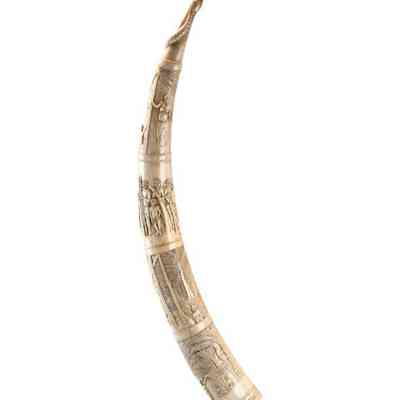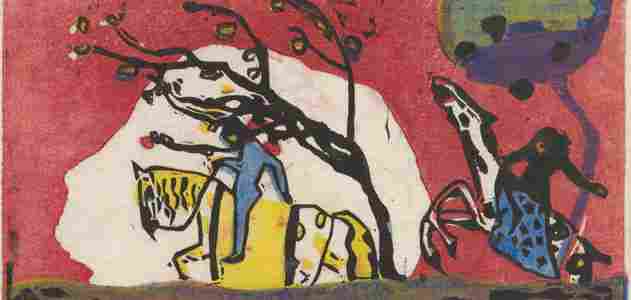Spirals of History



In 1882, Robert Visser, a German merchant who had been offered an opportunity to manage cacao and coffee plantations, traveled to central Africa's Loango Coast (in present-day Congo Republic). From then until his departure 22 years later, Visser avidly collected African art. His notable acquisitions included three outstanding examples of the region's intricately carved elephant tusks—artifacts newly added to the Smithsonian's National Museum of African Art. (Two of the ivories go on view this month in the exhibition "Treasures 2008," a sampling of works from the museum, supplemented by objects on loan.)
During his sojourn abroad, Visser, who was largely self-educated, took up photography and pursued it with dedication at a time when using an unwieldy camera under difficult conditions (in places where, for instance, one might become a lion's lunch) required as much toil as technique. While in Africa, Visser made some 500 photographs.
Visser's dual preoccupations—art collecting and photography—converge in the iconography of the tusks, which range in height from two to three feet and were acquired late last year from a Swiss collector. One of the pieces features a man standing by a big box camera (see Table of Contents, p. 4). Immediately, says curator Christine Mullen Kreamer, "we knew we had something unique."
The figure, almost certainly Visser himself, presides over a large-view camera mounted on a tripod. Each of the Visser ivories, moreover, features scenes that echo pictures made by Visser—a couple seated in a thatched-roof hut; African hunters displaying elephant tusks. One of the tusks contains a telling inscription at its base: "Mit Muth nur Kraft R Visser"—Only With Courage Is There Strength, R Visser.
The master artisans who created these pieces, says Kreamer, included various coastal peoples of the region, well-versed in a "long tradition of carving, mainly in wood." Among them were the Vili, who traditionally hunted elephants (the meat was a dietary staple). After the Portuguese arrived in the region toward the end of the 1400s, ivory tusks began to be exported, eventually for use in products such as piano keys and billiard balls. For travelers, missionaries and foreign workers in the rubber and cacao trades, elephant tusks became souvenirs of choice.
"Ivories had been a symbol of prestige among the Vili, who were the primo elephant hunters in that part of the continent," says Kreamer. "But tribal tusks weren't necessarily elaborately carved." Beginning in the 1830s, finely worked tusks, often commissioned by foreigners, began to appear. These, Kreamer adds, tended "to depict genre scenes in a highly naturalistic way—local trades, workers, scenes of struggle, animals, ritual activities. Often there would be a commissioned inscription as well, such as ‘Memories of Savage Africa.'"
Ultimately, of course, the appetite for ivory spelled doom for Africa's elephant herds. In an attempt to curb the slaughter, an international ban on the sale of new ivory was imposed in 1989. (The ban does not apply to antique ivory objects.) At first, the restrictions proved largely successful. Today, however, a worldwide market for new ivory trinkets, readily available on the Internet, has surged. Estimates from the Center for Conservation Biology at the University of Washington suggest that in 2006 alone, poachers smuggled 240 tons of ivory out of Africa, an amount corresponding to the destruction of 24,000 elephants.
Visser's 19th-century tusks document a vanished world and reveal, says Kreamer, a wealth of information about the flora, fauna and clothing of the time. The pieces also offer a sense of the complex interactions among Africans and Europeans—including the more brutal aspects, such as chaining workers together in forced labor. Each tusk bears a distinctive carved band, twining from base to tip and connecting scenes and characters. This defining motif caused Kreamer and her colleagues to create the term now used to describe Loango ivories in general (and this trio in particular): "spirals of history."
Owen Edwards is a freelance writer and author of the book Elegant Solutions .
In Politics, Just Follow the Signs

Many of us believe that the world has been going straight downhill since the fall of the Roman Empire. Rome, founded in 753 B.C., survived as a kingdom, a republic or an empire until about A.D. 476. Any society that can survive 1,229 years must be doing something right.
One reason Rome flourished as long as it did was that public policy was determined by signs and portents. Nobody ever did anything in ancient Rome without first reporting that he had seen two eagles dueling over a dead goat, or a hailstorm miraculously erupting from the Praetorian Guards' favorite fig bowl. These omens were used to justify everything: invading Thrace, deposing a rival, raising taxes, even divorcing your spouse so you could marry someone younger or richer from Egypt.
By and large, the Roman people did not object to the capricious actions of its leaders, as long as they were accompanied by at least one sign or portent. But it had to be a good sign or portent, not one of those "a little birdie told me" type things.
Thus, when Augustus announced that he was taking over Rome in 43 B.C., the public was initially taken aback:
"You can't just waltz in and seize power like that. What do you take us for, clowns?"
Augustus: "Oh, I forgot to tell you. Twelve vultures appeared around lunchtime last Thursday, and, as everyone knows, a surprise visit by more than five vultures signifies that it's OK for me to topple the republic, confiscate everyone's money and exile everyone I don't like."
Relieved public: "Fine. But next time, could you try telling us about the signs and portents first? I mean, really."
Signs and portents continued to play a role in societies throughout the Middle Ages and did not go out of fashion until the time of Scotland's Robert the Bruce, who was encouraged by a spider to declare himself king and throw out the English. (The spider may have been French.)
The disappearance of such omens has been a great loss to all of us, as they make it much easier for people to deal with sudden shifts in policy, surprise firings or bad news about the economy.
Nowadays, politicians hold a press conference and announce they have to raise taxes to meet unanticipated, but wholly necessary, expenditures. Nobody really believes any of this; taxes get raised because politicians like to raise taxes. How much easier it would be to accept these dire pronouncements if they were accompanied by signs and portents.
"We're going to raise your school taxes by 12 percent," the head of the city council could announce. "Last week, I saw 12 dead catfish in the fountain outside Bailey's Drugstore. Obviously, each catfish portends a 1 percent tax increase. Look on the bright side: at least there weren't 25 of them."
"I'm raising the prime interest rate a half point," the chairman of the Federal Reserve might proclaim. "This is partially to battle inflation, but mostly because I saw two flaming comets in the sky and each of them represented a quarter-point increase in the prime."
How likely is it that signs and portents will ever be adopted by the American people? More likely than you think. Just last week, my best friend said that a cluster of mighty birds of prey hovering over his backyard was a sure sign the Philadelphia Eagles would win the Super Bowl this season.
I disagree. I think the hovering birds signify a tax hike. Much as I would like to believe that signs and portents say otherwise, you have to be realistic about this stuff.
Joe Queenan , the author of nine books, writes regularly for the New York Times , the Los Angeles Times and the Guardian .
Matthew Gurewitsch on “Karsh Reality”

What drew you to this story? I was drawn to the challenge of a subject that was virtually unknown to me. Of course, I had seen many Karsh portraits before. But in the past, I had always looked at the sitter without giving much thought to the photographer. It was fun to turn the camera around, so to speak.
What surprised you the most while covering this story? I was flabbergasted, honestly, to think how widely Karsh traveled. Getting around wasn't so easy in his day. I was surprised, too, that, with the success he enjoyed, he might have become a prima donna, but he never did.
Were there any interesting moments that didn't make it to the final draft? There's a vast body of work—photojournalism, essentially, but also some experimental stuff—that simply did not fit the portrait of the photographer I had been asked to write. A comprehensive appreciation of Karsh would have to take this material into account. But I can't say I feel that we short-changed Karsh, really. It was portraiture that brought him fame and fortune, and it is portraiture for which he is remembered.
In your article you discuss Karsh's detractors. In your opinion, what defines Karsh's work as fine art instead of pop culture kitsch? So much of such pigeonholing is in the eye of the beholder. What some people call kitsch may be based on deliberate, painstaking, and highly self-conscious craftsmanship, as is the case with Karsh. He delivered a quality product. He had total command of his medium. Maybe that's enough to classify it as fine art, which is clearly what Karsh was aiming for. But in a rough-and-tumble age like ours, the very ideal of "fine art" seems a little dowdy and passé. Our taste generally is for portraiture that is much livelier, less preoccupied with the dignified facade. When we see recent glamour photographs à la Karsh, we usually suspect an ironic or at least "knowing" intent. Speaking for myself, I don't think I'd call Karsh a fine artist, because the label sounds so lofty, and his work, for all its aspirations, was intended for the mass market (as exemplified by LIFE magazine). But for the very reasons I raise as objections, the label may be exactly right.




Post a Comment